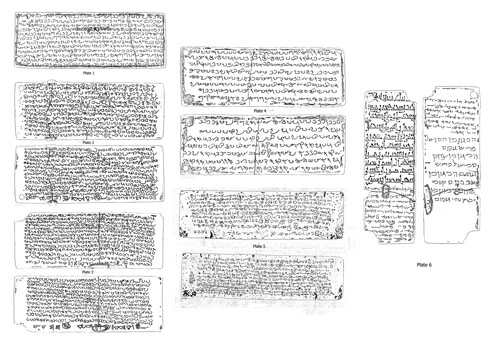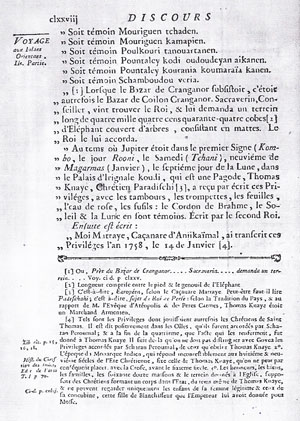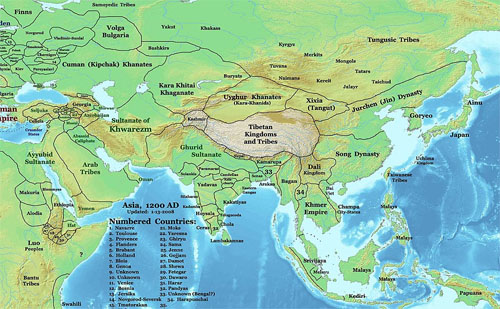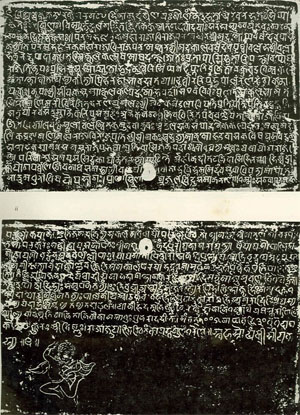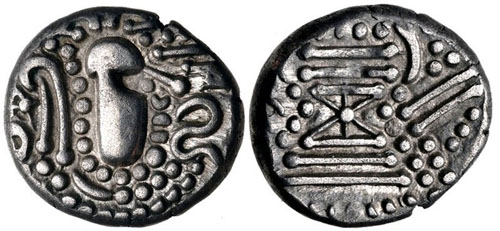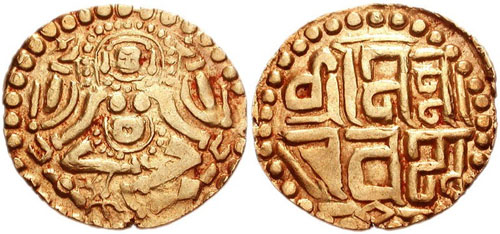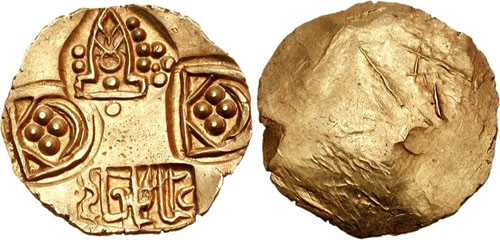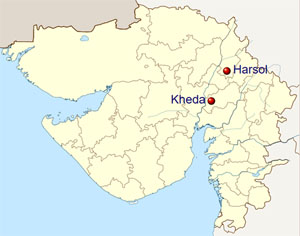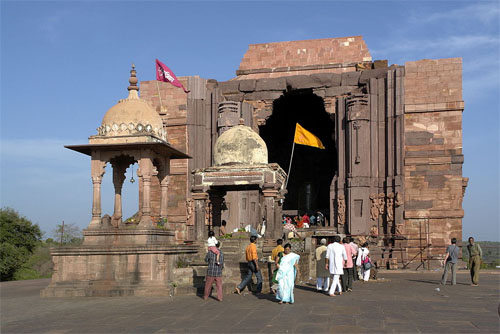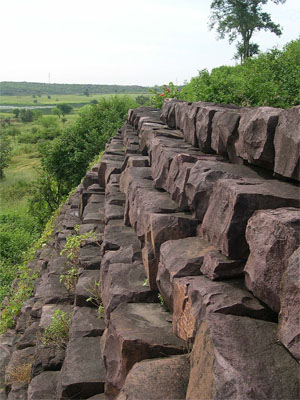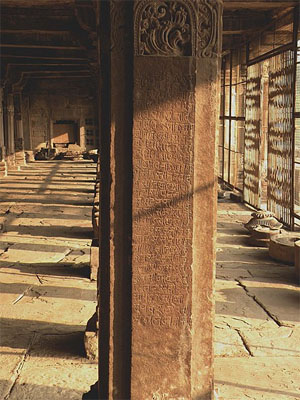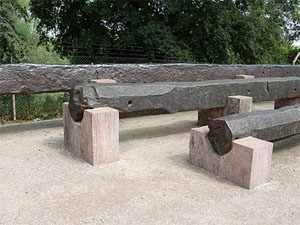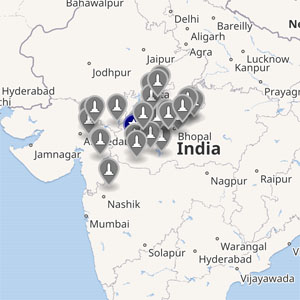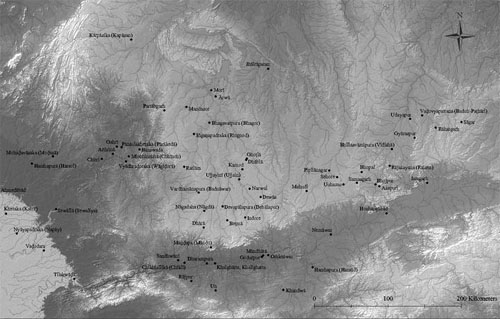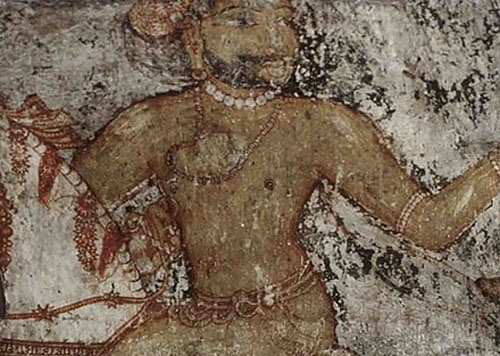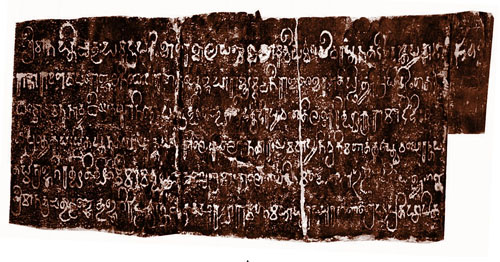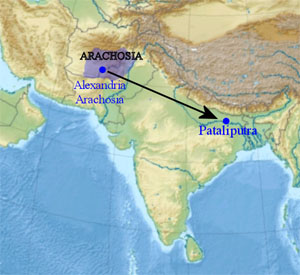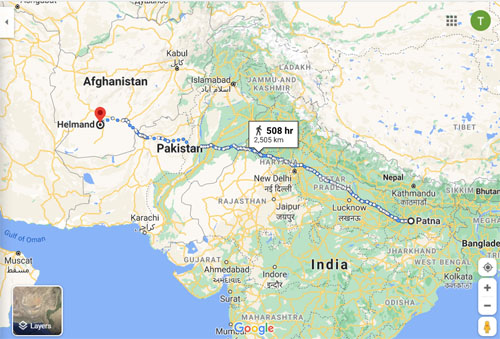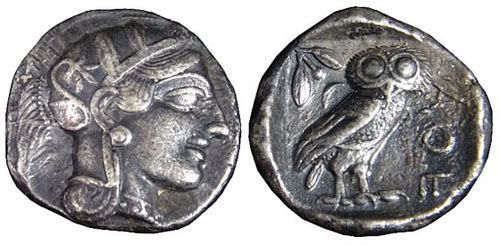A Question of Priority: Revisiting the Bhamaha-Dandin Debate
by Yigal Bronner
University of Chicago, 1130 E. 59th St., Chicago, IL 60637-1546, USA
e-mail: [email protected]
Published online: 29 April, 2011
© Springer Science+Business Media B.V. 2011
"How's your mother?"
"She's fine, although you might try and clear up that misunderstanding about Emma Hamilton."
"Emma and I -- I mean Lady Hamilton and I -- are simply 'good friends.' There's nothing to it, I swear."
"Tell her that."
"I try, but you know what a temper she has. I only have to mention I've been anywhere near the turn of the nineteenth century and she gets in a frightful strop."
I looked around.
"Where are we?"
"Summer of '72," he replied. "All well at work?"
"We found a thirty-third play by Shakespeare."
"Thirty-three?" echoed my father. "That's odd. When I took the entire works back to the actor Shakespeare to distribute there were only eighteen."
"Perhaps the actor Shakespeare started writing them himself?" I suggested.
"By thunder you could be right!" he exclaimed. "He looked a bright spark. Tell me, how many comedies are there now?"
"Fifteen."
"But I only gave him three. They must have been so popular he started writing new ones himself!"
"It would explain why all the comedies are pretty much the same," I added. "Spells, identical twins, shipwrecks --"
"-- usurped Dukes, men dressed as women," continued my father. "You could be right."
"Wait a moment--!" I began. But my father, sensing my disquiet over the many seemingly impossible paradoxes in his work in the timestream, silenced me with his hand.
"One day you'll understand and everything will be more different than you can, at present, possibly hope to imagine."
I must have looked blank, for he checked the road again, leaned against the back of the billboard and continued:
"Remember, Thursday, that scientific thought, indeed, any mode of thought whether it be religious or philosophical or anything else, is just like the fashions that we wear -- only much longer-lived. It's a little like a boy band."
"Scientific thought a boy band? How do you figure that?"
"Well, every now and then a boy band comes along. We like it, buy the records, posters, parade them on TV, idolize them right up until --"
"-- the next boy band?" I suggested.
"Precisely. Aristotle was a boy band. A very good one, but only number six or seven. He was the best boy band until Isaac Newton, but even Newton was transplanted by an even newer boy band. Same haircuts -- but different moves."
"Einstein, right?"
"Right. Do you see what I'm saying?"
"That the way we think is nothing more than a passing fad?"
"Exactly. Hard to visualize a new way of thinking? Try this. Go thirty or forty boy bands past Einstein. Where we would regard Einstein as someone who glimpsed a truth, played one good chord in seven forgettable albums."
"Where is this going, Dad?"
"I'm nearly there. Imagine a boy band so good that you never needed another boy band ever again. -- or even any more music. Can you imagine that?"
"It's hard. But yes, okay."
He let this sink in for a moment.
"When we reach that boy band, my dear, everything we have ever puzzled about becomes crystal clear -- and we will kick ourselves that we hadn't thought of it earlier!"
"We will?"
"Sure. And you know the best thing about it? Its so devilishly simple."
"I see," I replied, slightly dubiously. "And when is this amazing Boy Band discovered?"
Dad suddenly turned serious.
"That's why I'm here. Perhaps never -- which would be frightfully awkward in the grand scheme of things, believe me. Did you see a cyclist on the road?
"Yes?"
"Well," he said, consulting the large chronograph on his wrist, "in ten seconds that cyclist will be knocked over and killed."
"And--?" I asked, sensing that I was missing something.
He looked around furtively and lowered his voice.
"Well, it seems that right here and now is the key event whereby we can avert whatever it is that destroys every single speck of life on this planet!"
I looked into his earnest eyes.
"You're not kidding, are you?"
He shook his head.
"In December 1985, your 1985, for some unaccountable reason, all the planet's organic matter turns to ... this."
He withdrew a plastic specimen bag from his pocket. It contained a thick pinkish opaque slime. I took the bag and shook it curiously as we heard a loud screech of tires and a sickly thud. A moment later a broken body and twisted bicycle landed close by.
"On the 12th December at 20:23, give or take a second or two, all organic material -- every plant, insect, fish, bird, mammal and the three billion human inhabitants of this planet -- will start turning to that. End of all of us. End of Life -- and there won't be that boy band I was telling you about. The problem is --" he went on as a car door slammed and we heard feet running towards us -- "that we don't know why. The ChronoGuard are not doing any upstreaming work at present."
"Why is that?"
"Labor dispute. They're on strike for shorter hours. Not actually less hours, you understand, just the hours that they do work they want to be -- er -- shorter."
"So while the upstreamers are on strike the world could end and everyone will die, including them? But that's crazy!"
"From an industrial action viewpoint," said my father, furrowing his brow and going silent for a moment, "I think it's a very good strategy indeed. I hope they can thrash out a new agreement in time."
"And we'll know if they don't because the world ends?" I remarked sarcastically.
"Oh, they'll come to some arrangement," explained my father, smiling. "The dispute regarding undertime rates lasted almost two decades -- time's easy to waste when you've got lots of it."
"Okay," I sighed, unwilling to get too embroiled in SO-12 labor disputes, "what can we do about averting this crisis?"
"Global disasters are like ripples in a pond, Sweetpea. There is always an epicenter, a place in time and space where it all begins, however innocuously."
-- Lost In A Good Book, by Jasper Fforde
Abstract
As has been obvious to anyone who has looked at them, there is a special relationship between the two earliest extant works on Sanskrit poetics: Bhamaha’s Kavyalamkara (Ornamenting Poetry) and Dandin’s Kavyadarsa (The Mirror of Poetry). The two not only share an analytical framework and many aspects of their organization but also often employ the selfsame language and imagery when they are defining and exemplifying what is by and large a shared repertoire of literary devices. In addition, they also betray highly specific disagreements regarding the nature and aesthetic value of a set of literary phenomena. It has thus long been clear to Indologists that the two are in conversation with one another, but the nature of the conversation and its directionality have never been determined: Was Bhamaha responding to Dandin's Kavyadarsa? Was Dandin making a rejoinder to Bhamaha’s Kavyalamkara? Were the two authors contemporaries who directly interacted with one another? Or was their interaction indirect and mediated through other texts that are no longer extant? Determining the nature of the interrelations between the two authors and their texts may teach us a great deal about the origins of Sanskrit poetics, the direction in which it developed during its formative period, and the way in which some of the disagreements between Dandin and Bhamaha metamorphosed in later time. By reviewing existing scholarship, considering new evidence, and taking a fresh look at some of the passages that have long stood at the center of this debate, this article sets out to answer the question of the texts’ relationship and relative chronology.
1. Background: Old Controversy, New Approach
The debate that this article revisits is a century old. It began in the early 1900s, when manuscripts of Bhamaha’s treatise, hitherto thought to be lost, first came to light. As soon as scholars began to examine this text, its special relationship with the already-available work of Dandin became evident. An early trickle of attempts to fix the authors’ relative chronology actually antedated [come before] the publication of Bhamaha’s work in 1909.1 With this publication, however, the debate entered its formative period of roughly two decades. This was a time of extremely lively and notoriously rancorous discussion,2 with challenges and rejoinders appearing only months apart, often in consecutive issues of journals such as the Indian Antiquary, the Journal of the Royal Asiatic Society, and the journal of this society’s Bombay branch. It was during this period that most of the questions that have haunted the debate since— such as the perplexing [completely baffling] relationship between about a dozen parallel [extending in the same direction, equidistant at all points, and never converging or diverging] passages in Dandin's and Bhamaha’s works, and the identity of one Nyasakara to whom Bhamaha refers—became fixtures, and the main camps were formed. Among those arguing for Dandin's priority were eminent scholars such as P. V. Kane, Arthur Berriedale Keith, and K. B. Pathak. The camp maintaining Bhamaha’s priority brandished its own list of luminaries, including K. P. Trivedi, Hermann Jacobi, Johannes Nobel, and Sushil Kumar De.
Beginning in the 1930s, energy seems to have been gradually sucked out of this discussion. New participants did join the fray, but usually by repeating an already fixed set of arguments and counterarguments.3 When new editions of De’s, Keith’s, and Kane’s histories of Sanskrit poetics and Sanskrit poetry appeared in the 1940s, 1950s, and 1960s, they repeated their authors’ familiar positions but offered little or no fresh corroboration. A new generation of scholars in India and the West seems to have grown weary of this exchange and came to preach caution. Edwin Gerow, who in 1977 published his Indian Poetics, dubbed the Dandin-Bhamaha question the ‘‘toughest chronological problem’’ of the field and suggested that the two authors may have been contemporaries, for their ‘‘fundamental agreements and the acerbity of their disagreements’’ could be best explained by assuming a direct dialogue between them.4 But the sources Gerow cited all go back to the 1910s and 1920s, and his conclusion may be taken to reflect the seemingly insoluble nature of the older debate. What Gerow overlooked is the potential importance of evidence that had surfaced since 1930. First, a growing body of research pointed to Dandin's ties to the Pallava court in Kancı, including the 1954 publication of a second manuscript of the Avantisundarı and a pair of books on Dandin's life and works by D. K. Gupta (Gupta 1970, 1972). Second, and equally important, the oldest extant commentaries on Dandin's treatise, by Vadijanghaladeva and Ratnasrıjnana, were published in 1936 and 1957, respectively. Both Gerow and Gupta were familiar with these commentaries, but Gerow never considered their potential relevance to deciding the chronological question whereas Gupta summarily dismissed it.5 This approach is not accidental and reflects a common mistrust of traditional testimony, especially in matters of historicity.
I do not share this a priori suspicion. In fact, I believe that the specific difficulties of the problem at hand call for reliance on these commentaries. One such difficulty is the loss of all the earlier treatises on poetics, texts that Dandin and Bhamaha knew and cited. This loss makes it impossible to determine with absolute certainty, in those cases where one of the authors is refuting a position upheld by the other, whether he is indeed taking issue with the position as it is stated in the other’s work, or whether he is referring to it as postulated in some earlier text, no longer available. Another major difficulty is dating Bhamaha and Dandin relative to other authors of their period, because the dates of many of these authors are also uncertain, and because textual echoes between, say, Bhamaha and another writer could be construed to prove borrowing in either direction, not to mention a more intricate relationship that involves additional parties, some of whose works are now lost. Clearly, then, we are faced with a daunting task of reconstructing a complex textual web primarily on the basis of two of its relics. Here is where deferring to the commentators’ judgment strongly recommends itself. These scholars were also engaged in the task of reconstructing the textual relations of their root texts, but unlike us, they had access to portions of the older corpus that are no longer available, and they enjoyed a better vantage point by virtue of living at a time when personal information about Dandin and Bhamaha was more likely to be available. If we want to get closer to answering our difficult textual and chronological questions, why ignore the commentators’ explicit and copious testimony about them?
... a common mistrust of traditional testimony, especially in matters of historicity.
The disregard of the commentaries on Dandin's work is thus particularly baffling. Not only did they not receive any serious scholarly attention throughout the twentieth century, but some of them, particularly the oldest and, at least in this sense, most important, have become increasingly inaccessible.6 This amazing neglect seems indicative not just of the aforementioned mistrust of commentators, but also of a more general disinterest in the early history of Sanskrit poetics. As far as the Dandin-Bhamaha debate is concerned, the last three or four decades have not produced any major insights. The discussion of Dandin's Pallava roots eventually found its way into some Indological circles.7 Likewise, a few new arguments for one relative chronology or the other, typically in connection with comparisons of specific passages in both texts, were made,8 and new information regarding Bhamaha’s and Dandin's other conversation partners occasionally surfaced, though typically outside the discussion of poetics per se, as in the case of recent studies concerning Jinendrabuddhi, which took place almost exclusively in publications on Buddhist logic and Sanskrit grammar. But no attempt has been made to revisit this debate as a whole and incorporate the new evidence and arguments.
Such a new synthesis is the goal of this essay. To avoid the all-too-subjective judgments that dominated the earlier scholarship, I propose to examine new and old evidence in the following tripartite scheme: (1) Highest priority is given to external biographical evidence about Dandin and Bhamaha, either independently of each other, or, failing that, about their relative dating. This evidentiary category includes commentarial works that weigh in directly on these authors’ relative chronology. (2) Secondary priority is given to reviewing the comparison of passages from Dandin's and Bhamaha’s texts, on the one hand, and, on the other, parallel passages in the works of their predecessors, contemporaries, and successors (to the degree we can decide these matters), in order to determine the direction of borrowing and arrive at the lower and upper limits for their dates. Within this category, I prioritize cases where borrowing can be proved decisively and where the outside sources can be dated, at least with some certainty. (3) Finally, I revisit the comparison of parallel passages in Dandin's Kavyadarsa and Bhamaha’s Kavyalamkara in an attempt to postulate the most plausible pattern of their interaction. Here too, I try to formulate objective criteria for deducing the direction of textual exchange.
This scheme is not without its problems, partly because the distinction between the categories is occasionally fuzzy, and partly because the relative priority accorded to the evidence may be questioned. Thus in cases where the evidence from a lower category unmistakably contradicts that of a higher one, I will be willing to reconsider my scheme of relative priority. But, as I hope to demonstrate, the evidence is quite congruous, and hence these problems may not be as difficult as they initially seem. Let us, then, turn to the evidence in the order proposed above.
2. External Evidence
2.1 Dandin
Dandin is one of the best-known writers in all of Asian history. His Kavyadarsa traveled widely, was translated and adapted into Kannada, Sinhala, Pali, Tamil, and Tibetan, and may even have exercised influence on the formation of Recent Style Poetry in China.9 The work also attracted a large number of premodern Sanskrit commentators and was quoted profusely by many writers on Sanskrit poetics, including King Bhoja of Dhar (r. 1011–1055), who incorporated almost the entire Kavyadarsa into his treatises on poetics, and Appayya Dıksita (1520–1592), who showed a similar tendency in his relevant works.10
Because of his patronage to scholars, Bhoja became one of the most celebrated kings in the Indian history. After his death, he came to be featured in several legends as a righteous scholar-king. The body of legends clustered around him is comparable to that of the fabled Vikramaditya [a legendary emperor of ancient India. Often characterized as an ideal king, he is known for his generosity, courage, and patronage of scholars.]...
Legends
In terms of the number of legends centered around him, Bhoja is comparable to the fabled Vikramaditya. Sheldon Pollock describes Bhoja as "the most celebrated poet-king and philosopher-king of his time, and perhaps of any Indian time". Bhoja came to be featured in several legends as a righteous scholar-king, who was the ultimate judge of literary qualities and generously rewarded good poets and writers. Most of these legends were written three to five centuries after his death.
Apart from epigraphic records, much of the information about Bhoja comes from these legendary accounts, including Merutunga's Prabandha-Chintamani (14th century), Rajavallabha's Bhoja-Charitra (15th century), and Ballala's Bhoja-Prabandha (17th century). However, many of the popular legends about Bhoja do not have any historical basis. For example, the Bhoja-Prabandha anachronistically describes the ancient poet Kalidasa as a contemporary of Bhoja.
In order to enhance their imperial claims, the Paramaras promoted several legends associating Bhoja with the ancient legendary kings. For example, in Simhasana Dvatrimsika (popularly known as Singhasan Battisi), Bhoja finds a throne of Vikramaditya, and each of the 32 divine figurines attached to the throne tell him a story about Vikramaditya. A Bhavishya Purana legend describes Bhoja as a descendant of Vikramaditya and Shalivahana. According to this legend, the mleccha (foreign) influence had corrupted Indian culture by the time of Bhoja's ascension. Bhoja marched up to the banks of the Indus river, and defeated several mleccha kings. The poet Kalidasa, who accompanied him, magically turned into ashes a mleccha named Mahamada, whose followers came to be known as Muslim (The character Mahamada is based on Muhammad possibly combined with Mahmud of Ghazni). After returning to his capital, Bhoja established Sanskrit language among the top three varnas and Prakrit language among the Shudras. During his 50-year reign, Aryavarta (the land between the Himalayas and the Vindhyas) became a blessed land where the varna system was established. On the other hand, caste mixture took place beyond the Vindhyas (that is, in South India). Again, this is an imaginary account not supported by any historical evidence.
-- Bhoja, by Wikipedia
Only in the valley of Kashmir, which, starting in the ninth century, fashioned itself as the capital of the Sanskrit world and the headquarters of Sanskrit literary theory, was the Kavyadarsa rarely mentioned, a fact that reflects more a bias against Dandin than a lack of familiarity with his work, which was clearly studied there as well.11
Dandin's reputation as a poet is equally impressive, and he is one of a handful of poets placed, as a sign of esteem, in the legendary assembly of King Bhoja by late medieval and early modern writers.12 There are also quite a few popular verses praising his literary skills. Every Sanskrit student knows the floating verse mentioning Kalidasa’s simile, Bharavi’s weighty meanings, and Dandin's dancing words (padalalitya) as a prelude to Magha’s masterful combination of all three.13 Another famous anonymous verse singles Dandin out from the company of Kalidasa and his ilk by placing him in an exclusive triad with the tradition’s two founding fathers:
jate jagati valmıkau sabdah: kavir iti sthitah /
vyase jate kavı ceti kavayas ceti dandini //
Upon the birth of Valmıki
the word ‘‘poet’’ was coined.
With Vyasa it was first used in the dual.
And ‘‘poets,’’ in the plural, first appeared
along with Dandin.14
Indeed, a verse attributed to the theorist and poet Rajasekhara (fl. 920 CE) ...
Rama Rajasekhara (fl. 870/71–c. 883/84 AD) was a Chera Perumal ruler of medieval Kerala, south India. Rajasekhara is usually identified by historians with Cheraman Perumal Nayanar, the venerated Shaiva (Nayanar) poet-musician. Two temple records, from Kurumattur, Areacode and Thiruvatruvay, Vazhappally, mention king Rajasekhara.
Rajasekhara probably succeeded Sthanu Ravi Kulasekhara around 870 AD. It is also suggested that Cheraman Perumal Nayanar was on friendly terms with the Pallava dynasty.
The direct authority of the Chera Perumal king was restricted to the country around capital Makotai (Mahodaya, present-day Kodungallur) in central Kerala. His kingship was only ritual and remained nominal compared with the power that local chieftains (the udaiyavar) exercised politically and militarily. Nambudiri-Brahmins also possessed huge authority in religious and social subjects (the so-called ritual sovereignty combined with Brahmin oligarchy).
Rama Rajasehara probably abdicated the throne toward the end of his reign and became a Shaiva nayanar [hounds/teachers of Siva] known as Cheraman Perumal Nayanar. He was succeeded by Vijayaraga (fl. c. 883/84-c.895 AD).
Sources
• Shivanandalahari, attributed to Hindu philosopher Shankara, indirectly mentions the Chera ruler as Rajasekhara.A biography of Sri Sankara on modern lines is an impossible for want of exact data from contemporary writings. We have therefore to depend on the type of Sanskrit works called Sankaravijayas, the traditional lives of the Acharya, to know whatever is now possible to gather about this saintly philosopher…As these Vijayas have a mythological bias, they have their obvious defect in respect of chronology and recording of facts and events.
-- Sankara-Dig-vijaya: The Traditional Life of Sri Sankaracharya, by Madhava-Vidyaranya, Translated by Swami Tapasyananda
• Rajasekhara is also tentatively identified with king "Co-qua-rangon" mentioned in the Thomas of Cana copper plates.The Thomas of Cana copper plates (Malayalam: Knai Thoma Cheppedu), or Knanaya copper plates, dated variously between 345 C.E. and 811 C.E., are a lost set of copper-plate grants issued by the unidentified Chera/Perumal king of Kerala "Co-qua-rangon" to Syriac Christian merchants led by Knai Thoma (anglicized as Thomas of Cana) in the city of "Makotayar Pattinam" (present day Kodungallur), south India. The royal charters were reportedly engraved in Malayalam, Chaldean and Arabic on both sides of two copper plates (joined by a ring)...
Scholar M.G.S. Narayanan tentatively identifies king “Co-qua-rangon” with king Rama Rajasekhara (Co-qua-rangon → Ko Kotai Iraman → Rajadhiraja Rama) of the 9th century Chera Empire...
Translations of the existing Kollam [Quilon] Syrian Plates of the 9th century made by the Syrian Christian priest Ittimani [???] in 1601 as well as the French Indologist Abraham Anquetil Duperron in 1758 both note that the one of the plates mentioned a brief of the arrival of Knai Thoma. It is believed that this was a notation of the previous rights bestowed upon the Christians by Cheraman Perumal. The contemporary set however does not mention this paragraph....
The first written record of the Thomas of Cana copper plates dates to the 16th century when Portuguese officials in Kerala took notice of the plates and their later disappearance...
The final record of the plates comes from the official historian of Portuguese India Diogo do Couto in 1611. Do Couto claims to have seen the plates and makes an incomplete translation of its content.
-- Thomas of Cana copper plates, by Wikipedia
Rama Deva
Laghu Bhaskariya Vyakhya, a mathematical commentary composed in the court of king Ravi Kulasekhara in 869/70 AD, mentions a Chera Perumal royal called Rama Deva, who marched out to fight the enemies on getting information from the spies. A possibility identifies Rama Deva with Rama Rajasekhara. Rama Deva is described as a member of the Solar Dynasty ("ravi-kula-pati") in Chapter IIII, Laghu Bhaskariya Vyakhya.
Patron of Vasubhatta
Vasubhatta, a famous Yamaka poet of medieval Kerala, names his patron king as "Rama". A later commentary on a poem by Vasubhatta says that "Kulasekhara" was the regnal title of king Rama. Scholars generally consider this a result of confusion on the part of the commentators (between Sthanu Ravi Kulasekhara and Rama Rajasekhara) who were separated in time from Vasubhatta. Some scholars also identify king Rama Kulasekhara as the patron of poet Vasubhatta (and thus placing Vasubhatta in 11th-12 centuries AD). This view is generally found unacceptable on several counts.
-- Rama Rajasekhara, by Wikipedia
... puts Dandin in a class by himself by speaking of yet another triad, that of his works, and comparing it, among other things, to the trinity of gods and the trilogy of Vedic scripture:
trayo ‘gnayas trayo devas trayo vedas trayo gunah/
trayo dandiprabandhas ca trisu lokesu visrutah//
There are three fires, three gods,
three Vedas, three qualities,
and three works by Dandin.
Everything that is great in this triple world
comes in threes.15
Dandin's celebrity notwithstanding, his actual corpus has been rather poorly preserved, so much so that it is not entirely clear what list of three books Rajasekhara actually had in mind. There is, of course, the Kavyadarsa itself, a work that seems to have reached our hands in a complete form.16 A second work by Dandin, which seems to have pioneered the genre of poems narrating the two great epics simultaneously, was lost in its entirety; we know about it from a discussion of this genre in Bhoja’s Srngaraprakasa, where one relic verse from Dandin's lost poem is given as an example.17 Then there is the Dasakumaracarita (What Ten Young Men Did), a prose work that has come to us in a highly incomplete form and whose ‘‘headless, tailless torso’’ is now ‘‘sandwiched between two secondary paraphrases of the missing sections of [Dandin's] original work.’’18 Finally, there is the Avantisundarı, or Avantisundarıkatha (The Story of the Beautiful Lady from Avanti), also in prose, whose transmission is even poorer. Only a couple of fragmentary manuscripts of this work have survived, both of which break off at a relatively early stage, after the author introduces himself, describes the context and inspiration for the work’s composition, and begins to lay out the frame of a highly expansive narrative. There exists, however, a later Sanskrit work that sums up the larger prose narrative of the Avantisundarı in verse. This Avantisundarıkathasara (Gist of the Story of the Beautiful Lady from Avanti) is also incomplete, as is a thirteenth-century Telugu translation, but both go well beyond the point where the fragmented katha manuscripts stop and significantly overlap with the main part of Dandin's other prose work, the Dasakumaracarita.19
This confusing state of affairs has naturally left scholars puzzled about the size and exact nature of Dandin's oeuvre. Given the intriguing overlap between the two fragmented prose works, some scholars have suggested that the two were parts of the same whole and that the Avantisundarı supplied the missing head of the truncated Dasakumaracarita.20 But many initially treated the Avantisundarı with suspicion and even resentment.21 Scholars in this second camp argued that the prose works attributed to Dandin could not have been authored by the same person, and hence that there were two Dandins or perhaps, like everything else that is great in this world, even three.
In fact, the idea of multiple Dandins preceded the discovery and first publication of the Avantisundarı. In a brief note published in 1915, G. J. Agashe argued that an unbridgeable gap separates the Dasakumaracarita from the Kavyadarsa. The texts, he believed, were so different in their moral and literary values that it was simply inconceivable that they were by the same hand. Otherwise, one would have to accept ‘‘that an author, who, as an authority on Rhetoric, wrote like an angel of righteousness, should or could, as a poet, have been a veritable devil rolling in the mire of obscenity.’’22 In his 1919 edition of the Dasakumaracarita, Agashe reiterated his thesis that Dandin the ‘‘purist,’’ author of the Kavyadarsa, could not have been the same as the Dandin who penned many ‘‘lewd’’ passages in the Dasakumaracarita.23 The main problem with this argument is that the gap Agashe posits between the two texts is imaginary. It is based, on the one hand, on an entirely anachronistic attribution of Victorian values to Dandin the theoretician, who, counter to Agashe’s claims, was not at all opposed to sexual come-ons in literature so long as these involved a poetic twist, and, on the other, on a fundamental misapprehension of Dandin's prose as indecent or vulgar.24 In truth, when Agashe speaks of passages in the Dasakumaracarita that are ‘‘so outrageously obscene’’ that they must ‘‘bring a blush to the cheek of every cultured reader,’’ he speaks about himself rather than about the work’s intended readers.25
In addition to arguing for their alleged socioaesthetic incompatibility, Agashe cites ‘‘external evidence’’ for a vast chronological gap separating the two texts ascribed to Dandin. He places the Dasakumaracarita in the eleventh or twelfth century, much later than the Kavyadarsa, which he accurately locates in the Pallava capital of Kancı around the year 700 CE.26 This evidence consists of a mixture of conjectures based on silence (primarily the paucity of early references to the Dasakumaracarita)27 and far-fetched claims, such as that the work’s use of the word ‘‘Ionian’’ (yavana), which later referred to any newcomers from the west, including Muslims, indicates a time when Islam was already a dominant political force in South Asia, or that its mention of a bag containing betel nuts is a giveaway because ‘‘the practice of habitually chewing betel-nut is itself very modern.’’28 Finally, because Agashe found neither the ‘‘purist rhetorician’’ nor the author of ‘‘lewd’’ prose as deserving praise by the tradition, he deduced a third Dandin, about whom nothing whatsoever is known.29
I mention some of these absurd arguments because, as we shall see, Agashe is still invoked as an authority on the existence of multiple Dandins. Indeed, rather than settling the debate, the publication of the Avantisundarı in 1924, shortly after Agashe’s interventions, further fueled argumentation of the sort he made. In the late 1920s scholars such as Keith and De argued for the existence of wide stylistic gaps between the Avantisundarı and the Dasakumaracarita and claimed that the two could not have been by the same author, let alone parts of the same work.30
I find all this odd and indicative of a deep-rooted suspicion of any biographical testimony supplied by the relevant texts and later tradition. Indeed, this suspicion paradoxically stands in inverse relationship to the elaborateness and dependability of the testimony, so that the richer and better the data, the more profound the doubts. But the fact is that in the Avantisundarı, a work unmistakably ascribed to Dandin by its colophons and by later sources,31 the author provides uniquely ample information about himself and his surroundings. With the exception of Bana, whose Harsacarita likely served as Dandin's model here, no early Sanskrit writer ever provided such a detailed autobiographical account. Dandin begins with a lengthy description of the city of Kancı and of a Pallava king named Simhavisnu. When Simhavisnu holds court one day, a musician sings a beautiful verse blessing the presiding king; the singer of the verse then informs the king of its author, Damodara, hailing from the city of Anandapura. This up-and-coming poet, the king is told, came in contact with the great poet Bharavi. He also received patronage from a prince named Visnudharma. This relationship ended on a sour note, however, when the prince offended the vegetarian Damodara by offering him meat during a hunting expedition, after which incident Damodara joined the services of King Durvinıta from the Ganga lineage. On the basis of this recommendation, which included a sample verse and a short but impressive resume tying Damodara to some of the leading poets and royal houses of his time, Simhavisnu invites Damodara to join his court in Kancı. The 20-year-old Damodara is promptly recruited and enjoys a successful and fruitful tenure under Simhavisnu’s generous patronage.32 At this point in the narrative, Dandin turns to detail his own ancestry as the great-grandson of the young court poet: Damodara was married in Kancı and fathered three sons; his middle-born, Manoratha, had four sons; Manoratha’s youngest son, Vıradatta, married a Brahmin woman, Gaurı, and they had several daughters and, eventually, a son, Dandin. Dandin then reports that he lost his mother at the age of seven and his father shortly thereafter, and that as an orphan, he had to flee Kancı because of an enemy invasion and was able to return only once peace was restored.33
Although the story continues with many additional details about Dandin's friends and adventures in the port city of Mahamallapuram, during a visit to which he was inspired to compose his work,34 it is the information provided thus far that is most crucial for dating and locating the author. Particularly important is the fact that Dandin was four generations removed from Damodara, a contemporary of Kings Visnudharma, Durvinıta and Simhavisnu, all of whom can be dated with relative accuracy from inscriptional evidence and whose dates converge at the concluding decades of the sixth century and the beginning of the seventh.35 Also significant is the mention of a disruptive invasion of the Pallava kingdom, which is likely the Calukya sacking of Kancı described in the Gadval inscription of Vikramaditya I Calukya (dated to 674 CE).36 These details all suggest that Dandin's active career took place around 680–720 CE under the auspices of Narasimhavarman II Rajasimha in Kancı (r. 690/1–728/9).37 In all the scholarship written on this topic, I have not found a single good reason that we should dismiss this godsend of good and rich data.
Moreover, this autobiographical account strongly resonates with several hints from Dandin's Kavyadarsa, the same hints that initially led Agashe to assign Dandin's theoretical treatise to this very place and time. First, in explaining his concluding illustration of the poetic expression of joy (preyas), Dandin explicitly states that the joyous response just expressed was that of King Rajavarman or Ratavarman upon seeing Siva.38 The fact that Dandin here, outside any context, identifies a king as the author of this verse seems to me an obvious gesture to his patron. The question is, of course, who this patron is. The name is clearly Pallava-sounding (all Pallava regnal names invariably end in -varman), and if the reading Rajavarman is correct, then the identification that several scholars have suggested with Narasimhavarman II, also known as Rajasimha, seems likely, especially if we remember that this king is depicted in his inscriptions as a devotee of Siva.39 Second, one of Dandin's more striking examples of yamaka, the device where the same sound is repeated with a different meaning, is a verse whose sole purpose is the repetition of the name Kalakala as many times as possible in a single verse (24 times, to be precise). Kalakala is another famous title of Narasimhavarman II.40 Finally, the Kavyadarsa contains a verse illustrating a ‘‘name-riddle’’ (namaprahelika) that reads as follows: ‘‘A city, five letters, the middle one is a nasal, the ruling lineage of which is an eight-letter word.’’41 The answer, as the oldest commentator explains, is Kancı, capital of the Pallava (Pallavah) kings.42 As with the other hints, it is only natural to take the riddle as Dandin's gesture to the kings who supported him and to the hometown that he lovingly describes in his Avantisundarı.43 Indeed, all three works by Dandin seem to refer to the Tamil region: the Avantisundarı depicts Dandin as living and working in the Pallava region, and the Dasakumaracarita evinces familiarity with the region’s geography.44 To this we may add the strong fascination of all three works with Vidarbha: this region is the birthplace of Dandin's great-grandfather Damodara in the Avantisundarı, the location of several central stories in the Dasakumaracarita, and the place of origin of the best style of poetry in the Kavyadarsa.45
These biographical, geographic, and narrative convergences among all the works ascribed to Dandin are undeniable. And although the Avantisundarı was initially greeted with some suspicion—as is perhaps understandable, given its fragmentary nature, unclear relationship with the verse summary, and puzzling overlap with the Dasakumaracarita, another incomplete work with an odd pattern of transmission— there is now a wide consensus that a single Dandin authored all these works at the Pallava court in Kancı around the end of the seventh century.46 Indeed, several eminent scholars now believe on stylistic and other grounds that, as suggested by the verse summary and its Telugu translation, both the Avantisundarı and the Dasakumaracarita originally formed a single massive prose work that was broken up at a relatively early age in its transmission; another view is that the two represent separate stages in the life and work of the same author.47 Be that as it may, it should be noted that in the century since Agashe’s first intervention, not a shred of evidence has been found that positively supports the notion of multiple Dandins, and it is absolutely clear that in the eyes of posterity there never existed more than one.48 If there were several authors named Dandin, it would seem that they all lived in the same place and at the same time, wrote the same works, and were considered by everyone else to be one and the same person.
Despite all this, the ghost of Agashe has recently been resurrected as part of the ongoing debate concerning the history of the Ajanta caves. I will not try to summarize here Walter Spink’s career-long efforts to provide a revised, short chronology of this unique building project, which he believes was carried out in spurts from 460 to 477 CE, when it was finally stopped after the fall of the Vakataka Empire.49 It will suffice briefly to explain how Dandin's date and identity became linked to his ingenious, albeit controversial, theory. Although the bulk of Spink’s arguments is based on his innovative reading of Ajanta’s physical remains, a main source of external support is his interpretation of the Visruta story in Dandin's Dasakumaracarita as a lightly disguised account of the political drama surrounding the reign of Harisena, the last Vakataka monarch.50 Some of Spink’s critics strongly doubt the historicity of the Visruta story,51 although his interpretation is intriguing and certainly not implausible. But even if Spink’s interpretation is accepted, what bearing does this have on the question of Dandin's date and identity? Indeed, Spink himself originally concurred with Dandin's accepted date and even used it to support his argument. Thus he refers to the ‘‘fall of the great Vakataka house, a trauma so important in India’s history that it was recalled detail by detail, well over a century later in Dandin’s quasi-historical Dasakumaracarita.’’52
More recently, however, in responding to criticism that his ‘‘crown witness’’ lived ‘‘about 8 or 9 generations later, at the end of the 7th or early 8th century,’’ and that therefore ‘‘his intimate knowledge of Vakataka history should be taken with a pinch of salt,’’53 Spink seized on Agashe’s theory of multiple Dandins and suggested that the Dandin who authored the Dasakumaracarita must have lived much earlier, close to the events he allegedly describes.54 Even aside from the obvious circularity of this argument and the fact that no serious scholar would place the Dasakumaracarita circa 500 CE—as we have seen, Agashe, whom Spink quotes as his authority on the position of multiple Dandins, actually believed that the work was written as late as the twelfth century—I find the idea that Dandin had to witness history in order to allude to it (if this, indeed, is what he does) strange, to say the least. As Spink originally and rightly argued, the story of King Harisena was a famous one, and as we have seen, Dandin's great-grandfather hailed from the very region of the erstwhile Vakataka kingdom.55 So even if Dandin's Visruta story is in some sense about the historical drama in Harisena’s court, I find nothing in Spink’s arguments that seriously challenges the scholarly consensus about Dandin's period, supported by the detailed testimony in his Avantisundarı, or, for that matter, the tradition’s knowledge of only one Dandin. At any rate, the Kavyadarsa, Dandin's text that is most relevant to the current discussion, can be safely assigned to the Pallava court in Kancı around the year 700.
2.2 Bhamaha
In comparison with Dandin's celebrity and the relative wealth of information about him, we lack data about Bhamaha. He mentions in his Kavyalamkara that his father’s name was Rakrilagomin, and this is basically all we know about him.56 Later Kashmiri writers often treat Bhamaha as the founding father of Sanskrit poetics and, by the same token, make him stand for everything that is old school, a trend that must have begun with Udbhata (c. 800) and his vast commentary on Bhamaha’s work. This Kashmiri connection has led many to assume that Bhamaha, too, hailed from the northern vale. But if this is the case, then, unlike many of his followers, whose patrons, positions, and, in some cases, salaries are referred to by Kalhana, Bhamaha does not receive any mention in the famous chronicle of Kashmir’s courts, the Rajataranginı (River of Kings).57
Moreover, although his text was studied alongside Dandin's, Bhamaha never enjoyed anything like the impact of his colleague. His work did not serve as the dominant model for nascent vernacular literary cultures, nor did it attract many commentators; the only premodern commentary known to us is Udbhata’s, and this learned and important work is now lost save for a few fragments published by Gnoli in 1962 and some stray quotes in later works. Neither was Bhamaha a famous poet—there are only a handful of verses ascribed to him in the anthologies—and there are certainly no praise verses of the type dedicated to Dandin.58
However, it is possible that Bhamaha was known in the scholarly circles of grammar and logic, to each of which fields he dedicated a chapter in his manual on poetics. Indeed, it is often Bhamaha’s chapters on these other disciplines that engaged other texts in discussion and were cited by later authors in a way that is crucial to fixing his date. Thus Bhamaha’s views on the philosophy of language merited the attention of Santaraksita, a Buddhist logician writing in the middle of the eighth century, and his discussion on grammar refers to a certain Nyasakara. Speaking of grammar, a commentary on Vararuci’s Prakrtaprakasa, a Prakrit grammar, was written by a Bhamaha who may or may not be the same as the author of the Kavyalamkara.59

